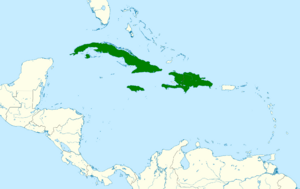Antillean palm swift facts for kids
Quick facts for kids Antillean palm swift |
|
|---|---|
 |
|
| Conservation status | |
| Scientific classification | |
 |
The Antillean palm swift (Tachornis phoenicobia) is a small, fast-flying bird that belongs to the swift family. You can find these birds on the Caribbean islands of Cuba, Jamaica, and Hispaniola. Hispaniola is the island shared by the Dominican Republic and Haiti.
Contents
About This Swift
What's in a Name?
The Antillean palm swift has two main types, called subspecies. Think of subspecies as slightly different versions of the same animal. The first one is called T. p. phoenicobia, and the second is T. p. iradii. Scientists use these names to tell them apart.
What Does It Look Like?
This swift is about 9 to 11 centimeters (3.5 to 4.3 inches) long. That's about the length of a small smartphone! It weighs around 9 to 11 grams (0.3 to 0.4 ounces), which is very light.
It has long, thin wings and a tail that looks like a fork. Both male and female swifts look the same. Their heads and backs are dark brown or black. The sides of their rumps (the area above their tail) are white. Their wings are dark, but the edges of their flight feathers are lighter.
Their faces are mostly grayish-brown. Their bellies are dull white, but their sides and a band across their chest are dark brown. Young swifts look similar to adults, but their white parts are even duller.
The T. p. iradii subspecies is a bit bigger. It also has a tail that is more deeply forked. Its back is more sooty brown than black, and its face has more gray-brown color.
Where Do They Live?
The T. p. phoenicobia subspecies lives on Jamaica, Hispaniola, and some small islands nearby. The T. p. iradii subspecies lives on mainland Cuba and a nearby island called Isla de la Juventud.
Sometimes, these swifts fly far from their usual homes. They have been seen in Florida, and there are reports of them in Puerto Rico, the Cayman Islands, and other Caribbean islands.
Antillean palm swifts like to live in dry, grassy areas. They often hang out where there are palm trees, bushes, forests, and even in towns and cities. They can be found at high elevations, up to 1,700 meters (5,600 feet) on Hispaniola.
Swift Behavior
Staying Put
These swifts usually stay in the same areas all year long. They don't migrate like some other birds, but individual birds might sometimes wander to new places.
What Do They Eat?
Like all swifts, the Antillean palm swift eats insects while flying. They fly low to the ground, often over plants, to catch their food. They usually hunt in small groups of their own kind. Sometimes, you might even see them hunting with swallows. Scientists don't know all the details of their diet yet.
How Do They Raise Their Young?
Antillean palm swifts breed in Cuba from May to July. On Hispaniola, they breed from March to May. They build a unique nest that looks like a hanging pouch. They make it from plant fibers and feathers, all glued together with their own saliva. They hang these nests on the outside of dead, drooping palm leaves.
These birds often nest in small groups, forming colonies. A female swift usually lays two to five eggs. Both parents take turns sitting on the eggs to keep them warm. They also both help care for the baby birds once they hatch.
What Do They Sound Like?
The Antillean palm swift makes a "noisy" call when it flies. It's described as a quiet, constant, twittering sound, like "tooee-tooee."
Their Status
The IUCN (International Union for Conservation of Nature) has looked at the Antillean palm swift. They have decided that this bird is of "Least Concern." This means that it's not currently in danger of disappearing.
The swift lives in a large area, and even though we don't know exactly how many there are, their numbers seem to be steady. There are no big threats to them right now. In fact, these swifts are good at living near people. Planting decorative palm trees even gives them more places to build their nests!


